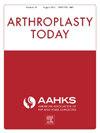One High-Volume Posteromedial Knee Capsular Injection Can Provide Safe Anesthetic Infiltration Across the Entire Posterior Knee Capsule
IF 1.5
Q3 ORTHOPEDICS
引用次数: 0
Abstract
Background
Anesthetic injection through the central or posterolateral knee capsule for analgesia after knee surgery risks popliteal vessel and tibial and peroneal nerve injury. We evaluated the distribution of a high volume of fluid injected through only the posteromedial capsule and compared it to a technique involving injections through the posteromedial and posterolateral capsules.
Methods
Four fresh cadaveric knees were injected with 50 ml of Omnipaque 350 diluted 1:4 with normal saline through the posteromedial knee capsule. In four other specimens, we followed a published protocol by injecting 12.5 ml posteromedially and 12.5 ml posterolaterally. The knees were then ranged 20 times over 20 minutes before obtaining a computed tomography scan to evaluate the spread of injected contrast fluid.
Results
Both techniques demonstrated broad distribution of injected fluid posterior to the capsule. An average of 80% of the capsular width at the level of the injection was within 5 mm of the injected contrast with the single injection, while 63% was with the two-injection technique.
Conclusions
One 50 mL injection through the posteromedial knee capsule can provide broad medial, lateral, superior, and inferior distribution of anesthetic without risking injury to neurovascular structures. This has become our preferred method of anesthetizing the posterior knee during knee surgery.
一次大容量膝后内侧囊注射可以提供安全的麻醉渗透整个膝后囊
背景:膝关节手术后通过膝关节中央或后外侧囊进行麻醉注射有损伤腘血管、胫腓神经的风险。我们评估了仅通过后内侧囊注射大量液体的分布,并将其与通过后内侧和后外侧囊注射的技术进行了比较。方法用生理盐水1:4稀释的Omnipaque 350 50 ml经膝关节后内侧囊注射4例新鲜尸体膝关节。在其他四个标本中,我们遵循已发表的方案,分别向后内侧和后外侧注射12.5 ml。然后在20分钟内对膝关节进行20次移动,然后进行计算机断层扫描以评估注射造影剂的扩散。结果两种技术均显示囊后注射液分布广泛。与单次注射相比,在注射造影剂水平上,平均80%的囊膜宽度在注射造影剂的5毫米内,而两次注射技术则为63%。结论经膝后内侧囊注射一次50 mL,可提供广泛的内侧、外侧、上、下分布,且不会损伤神经血管结构。这已成为我们在膝关节手术中首选的麻醉后膝关节的方法。
本文章由计算机程序翻译,如有差异,请以英文原文为准。
求助全文
约1分钟内获得全文
求助全文
来源期刊

Arthroplasty Today
Medicine-Surgery
CiteScore
2.90
自引率
0.00%
发文量
258
审稿时长
40 weeks
期刊介绍:
Arthroplasty Today is a companion journal to the Journal of Arthroplasty. The journal Arthroplasty Today brings together the clinical and scientific foundations for joint replacement of the hip and knee in an open-access, online format. Arthroplasty Today solicits manuscripts of the highest quality from all areas of scientific endeavor that relate to joint replacement or the treatment of its complications, including those dealing with patient outcomes, economic and policy issues, prosthetic design, biomechanics, biomaterials, and biologic response to arthroplasty. The journal focuses on case reports. It is the purpose of Arthroplasty Today to present material to practicing orthopaedic surgeons that will keep them abreast of developments in the field, prove useful in the care of patients, and aid in understanding the scientific foundation of this subspecialty area of joint replacement. The international members of the Editorial Board provide a worldwide perspective for the journal''s area of interest. Their participation ensures that each issue of Arthroplasty Today provides the reader with timely, peer-reviewed articles of the highest quality.
 求助内容:
求助内容: 应助结果提醒方式:
应助结果提醒方式:


